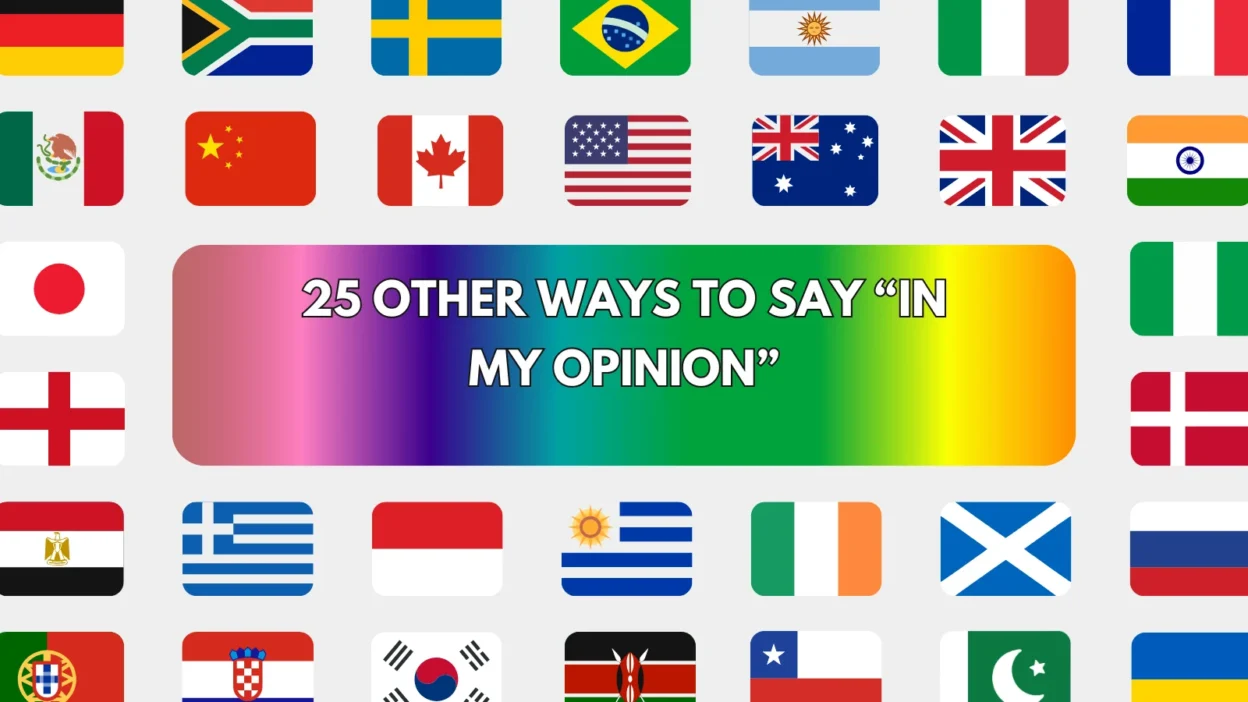The phrase “In my opinion” is commonly used to introduce personal views in conversations, debates, articles, or emails. It shows that you’re expressing a personal perspective rather than a fact. But using the same phrase repeatedly can feel monotonous or overly formal. That’s why learning alternative ways to say “in my opinion” helps keep your language fresh, persuasive, and more naturally conversational.
Below are 25 clear and compelling alternatives to saying “In my opinion,” each tailored for different tones and communication settings.
1. I believe
Meaning:
Expresses a personal conviction or viewpoint.
Detailed Explanation:
“I believe” sounds confident and is often used when stating a personal or reasoned stance.
Scenario Example:
I believe we should prioritize quality over quantity.
Best Use:
Formal discussions, persuasive writing.
Tone:
Confident, respectful.
2. I think
Meaning:
Indicates a personal thought or view.
Detailed Explanation:
Less formal than “I believe,” this phrase is great for casual conversations.
Scenario Example:
I think this method works better for most users.
Best Use:
Everyday conversations or informal writing.
Tone:
Casual, conversational.
3. To me
Meaning:
Highlights a personal interpretation or feeling.
Detailed Explanation:
Used when expressing how something appears or feels to you specifically.
Scenario Example:
To me, this painting represents freedom.
Best Use:
Personal reflections or creative contexts.
Tone:
Subjective, thoughtful.
4. From my perspective
Meaning:
Shows that you’re sharing your own point of view.
Detailed Explanation:
Adds clarity that you’re not assuming a universal truth.
Scenario Example:
From my perspective, remote work has boosted productivity.
Best Use:
Professional or opinionated discussions.
Tone:
Balanced, insightful.
5. As I see it
Meaning:
Reveals how you understand or interpret something.
Detailed Explanation:
Slightly conversational and great for softening strong opinions.
Scenario Example:
As I see it, the issue lies in poor communication.
Best Use:
Group discussions, meetings.
Tone:
Open, reflective.
6. I would say
Meaning:
Offers a tentative opinion or suggestion.
Detailed Explanation:
This phrasing softens your opinion, making it sound less forceful.
Scenario Example:
I would say the team handled the situation well.
Best Use:
Polite debates, feedback sessions.
Tone:
Tactful, gentle.
7. If you ask me
Meaning:
A casual way to introduce your viewpoint.
Detailed Explanation:
Best used in informal conversations, especially when someone hasn’t explicitly asked.
Scenario Example:
If you ask me, they rushed the decision.
Best Use:
Friendly chats or casual settings.
Tone:
Relaxed, opinionated.
8. I feel that
Meaning:
Indicates an emotional or subjective perspective.
Detailed Explanation:
Emphasizes emotional intelligence or intuition behind the opinion.
Scenario Example:
I feel that more transparency would improve trust.
Best Use:
Empathetic conversations or reflective writing.
Tone:
Personal, emotional.
9. It seems to me
Meaning:
Suggests an observation that may be tentative or open-ended.
Detailed Explanation:
A modest and polite way to share your view.
Scenario Example:
It seems to me that we need a new strategy.
Best Use:
Constructive feedback, brainstorming.
Tone:
Humble, analytical.
10. My view is
Meaning:
A direct expression of a personal stance.
Detailed Explanation:
Sounds formal and clear, good for structured discussions.
Scenario Example:
My view is that we need stricter deadlines.
Best Use:
Meetings, written opinions.
Tone:
Assertive, formal.
11. In my view
Meaning:
An alternative to “in my opinion” that feels slightly more elegant.
Detailed Explanation:
Less commonly used than “in my opinion,” making it feel fresh.
Scenario Example:
In my view, the report lacks clarity.
Best Use:
Formal writing, reports.
Tone:
Professional, composed.
12. Personally, I think
Meaning:
Emphasizes that what you’re about to say is your personal belief.
Detailed Explanation:
Adds a touch of humility while stating your thoughts.
Scenario Example:
Personally, I think the idea has great potential.
Best Use:
Balanced opinion-sharing.
Tone:
Humble, respectful.
13. I’m of the opinion that
Meaning:
A formal and clear way to state your opinion.
Detailed Explanation:
This sounds authoritative, ideal for structured writing.
Scenario Example:
I’m of the opinion that stricter policies are needed.
Best Use:
Essays, editorials, business cases.
Tone:
Academic, professional.
14. I’d suggest that
Meaning:
Proposes an idea while expressing personal input.
Detailed Explanation:
Softens your opinion by making it sound like advice.
Scenario Example:
I’d suggest that we revisit the marketing plan.
Best Use:
Collaborative work, feedback.
Tone:
Cooperative, respectful.
15. To my mind
Meaning:
An old-fashioned but charming way of saying “in my opinion.”
Detailed Explanation:
This adds a slightly poetic or literary flair.
Scenario Example:
To my mind, that was his finest performance yet.
Best Use:
Literary writing, thoughtful conversations.
Tone:
Elegant, classic.
16. I take the view that
Meaning:
Expresses your established opinion or stance.
Detailed Explanation:
Sounds formal and used when presenting a reasoned argument.
Scenario Example:
I take the view that consistency builds trust.
Best Use:
Debates, formal discussions.
Tone:
Strong, authoritative.
17. I reckon
Meaning:
An informal way of saying “I think” or “I believe.”
Detailed Explanation:
More common in British or Australian English.
Scenario Example:
I reckon we’ll finish on time if we stay focused.
Best Use:
Casual conversation, regional slang.
Tone:
Relaxed, informal.
18. I assume that
Meaning:
Shares a belief based on available information.
Detailed Explanation:
Slightly speculative, but shows reasoned thinking.
Scenario Example:
I assume that most customers prefer simplicity.
Best Use:
Data-based opinions or analysis.
Tone:
Neutral, analytical.
19. I’d argue that
Meaning:
Introduces a viewpoint you’re willing to defend.
Detailed Explanation:
Used when presenting a well-thought-out or debatable opinion.
Scenario Example:
I’d argue that creativity matters more than speed.
Best Use:
Academic essays, formal debate.
Tone:
Persuasive, assertive.
20. My belief is that
Meaning:
Shares a strong personal or philosophical stance.
Detailed Explanation:
This has a bit more weight and depth than “I think.”
Scenario Example:
My belief is that kindness always pays off in the end.
Best Use:
Values-based statements or reflections.
Tone:
Thoughtful, earnest.
21. I’d personally go with
Meaning:
Suggests your personal preference in a casual way.
Detailed Explanation:
Sounds natural and conversational, great for choosing between options.
Scenario Example:
I’d personally go with the darker color scheme.
Best Use:
Design choices, product decisions.
Tone:
Friendly, subjective.
22. I suppose
Meaning:
Indicates a softer or more tentative opinion.
Detailed Explanation:
Useful when you’re not 100% certain, or open to other views.
Scenario Example:
I suppose we could try a different vendor this time.
Best Use:
Tentative suggestions.
Tone:
Humble, gentle.
23. In my honest opinion (IMHO)
Meaning:
Emphasizes sincerity when giving your viewpoint.
Detailed Explanation:
Often used in online discussions and messages.
Scenario Example:
In my honest opinion, the book was overrated.
Best Use:
Informal writing, online comments.
Tone:
Candid, honest.
24. I gather that
Meaning:
Implies an opinion formed from observation or experience.
Detailed Explanation:
Used when your view is based on indirect knowledge or feedback.
Scenario Example:
I gather that customers prefer faster checkout options.
Best Use:
Customer feedback, reviews.
Tone:
Inquisitive, thoughtful.
25. I’m convinced that
Meaning:
Expresses a strong belief with full confidence.
Detailed Explanation:
Great when you want to sound firm and persuasive.
Scenario Example:
I’m convinced that this approach will yield better results.
Best Use:
Persuasive writing, leadership communication.
Tone:
Confident, bold.
Conclusion
Whether you’re expressing an idea, giving feedback, or contributing to a discussion, using different ways to say “In my opinion” adds clarity, variety, and style to your communication. From formal tones like “I’m of the opinion” to casual ones like “I think”, choosing the right alternative helps your message sound more natural and engaging.




